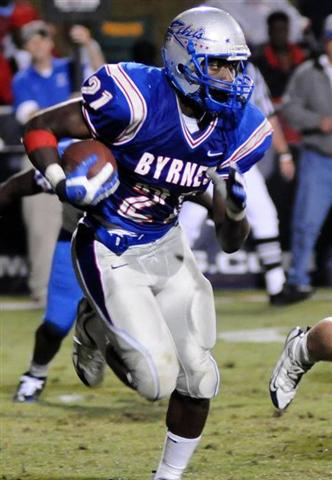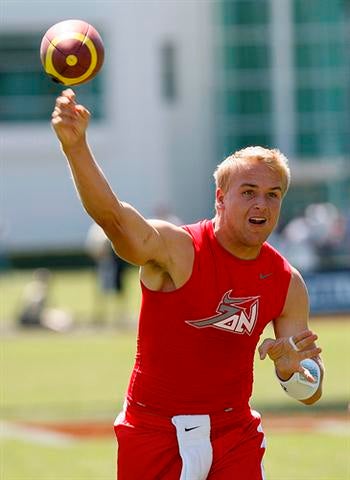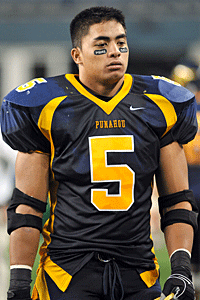MaxPreps Football Editor Stephen Spiewak gives five compelling reasons why it's possible; Other MaxPreps experts aren't nearly so sure.
Teenage athletes have made the transition from the amateur to professional ranks and barely missed a beat in basketball, baseball and hockey, to name a few.
However, traditional wisdom dictates that the National Football League is a unique environment, where a jump from the high school to professional status is impossible.

Byrnes (S.C.) junior Marcus Lattimore is already compared to NFL backs.
File Photo by Don Wessell
With the NFL draft just days away, MaxPreps writers weigh in on the notion that a high school senior could bypass college and hit the gridirons every Sunday.
MaxPreps Football Editor Stephen Spiewak offers five explanations why it is possible. Senior writers Mitch Stephens and Kevin Askeland along with Director of Editorial Content Steve Montoya counter with their opinions.
WHY A HIGH SCHOOL FOOTBALL PLAYER COULD JUMP RIGHT TO THE NFL
1. It has already happened
Stephen Spiewak: When analyzing the likelihood of if or how something will happen, we look for a precedent. For example, if one is predicting who will win a state title in high school football, the most valuable single piece of information would be what team won the state title in the previous season.
This question has already been answered. The last time it was attempted, it was a success.
Andy Livingston played on the 1964 Chicago Bears as a 19-year-old out of high school. He was a star running back and sprinter at Mesa High in Arizona. He never graduated because he got married and fathered a child, and subsequently stopped attending school.
In a desire to support his family, and through some fortuitous breaks, Livingston connected with George Halas, who owned the Chicago Bears. Impressed by Livingston’s physical gifts, Halas secured a hardship exemption for Livingston, making him eligible to play with the Bears that fall.
In his first game, the 6-foot-1, 235-pound Livingston returned a kickoff 86 yards for a touchdown. To provide some context for that impressive and rare feat, there were only two other kickoffs returned for scores in professional football that entire season.
How many NFL would stand in line to sign a high school player if it was worth a special teams touchdown? Considering that last year’s NFL playoff games were decided by an average of 9.8 points, my guess: 32.
Mitch Stephens: I applaud you for finding Mr. Livingston’s accomplishments but have you seen game film from 1964? Have you seen the bodies? Quite frankly high school kids of today are more physically imposing than NFL players from that era. We’re a couple generations removed from that era young Stephen and over the last 45 years the evolution of size and weight lifting and yes, “health and strength enhancements” have turned professional athletes into pretty much circus freaks. Yes, that “growth” has been somewhat proportional to high school kids but the far greater growth and full-time devotion to sport is from ages 18 to 22. Sure, there is a high school kid who could physically deal with a professional athlete one-on-one. But not 11 of them.
Steve Montoya: In 1964 Mike Ditka was the Bears’ tight end. Ditka is a name most of us are familiar with. Do you think Ditka would be a Hall of Famer if Antonio Gates and Tony Gonzalez were in his same class? In 12 NFL seasons, Gonzalez has 5,128 more receiving yards than Ditka. In only six years, Gates is less than 1,000 yards away from Ditka. Now Stephen Spiewak, you may be saying, “it was a different game back then.” Well, that’s entirely my point. Players are bigger, faster and stronger. Great high school athletes are used to being the fastest and most skilled players on the field, but in the NFL, the 6-4, 260-pound tight ends are just as fast, and even more skilled.
2. It happens in other sports
SS: What makes football so special?
Sports fans are well aware of the success that basketball players like Kevin Garnett, Kobe Bryant, and LeBron James have had, going straight from high school into the NBA, a league full of the world’s best athletes.
Tiger Woods made the cut at the Masters at 19, and won the Masters at 21. As a 17-year-old high school senior, he was probably better than most professional golfers.

Mater Dei senior Matt Barkley was pegged for the NFL as a sophomore.
Photo Courtesy of Nike
As a high school senior last year, Jeff Demps took second place in a 100-meter Olympic Trial heat behind only Tyson Gay. Demps was timed in a remarkable 10.01 seconds.
Six weeks after turning 19, Michael Phelps won six gold medals in the 2004 Summer Olympics.
Hockey, which rivals football in physicality, has seen an influx of young talent. Most notably, Sidney Crosby was sixth in the league in scoring as an 18-year-old rookie.
And what sport is more physically demanding than boxing? Look at it and its favorite bad boy, Mike Tyson.
As a child, Iron Mike could knock out most grown men. At age 13, he weighed 200 pounds. At 17, he nearly beat the eventual Olympic gold medal winner. His pro debut kicked off when he was 18, the age of most high school seniors. He rattled off 15 straight wins that year.
High school athletes have made the transition to the professional realms in a host of different sports, which require different physical gifts, skill sets and abilities. I reiterate: what makes football so special?
MS: I reiterate, this is the ultimate team game with massive amounts of moving parts, bodies and strategy. Again, one-on-one, right now, Bryce Brown might be able to run through or around Brian Urlacher, Garrett Gilbert might throw a tighter spiral than Drew Brees and Jamarkus McFarland might even match the speed and strength of Walter Jones. But this isn’t one-on-one. It’s not a race. It’s not a strength competition. It’s not a match against a stop watch. This is a remarkably competitive and complex game on a field with 22 freakishly gifted athletes on a 120-by-53 yard field with a couple dozen drill sergeant coaches screaming instructions, 80,000 fans cheering and millions of naysayers – not to mention hundreds of critical media – scrutinizing every move. Not to sound over-machismo, but this is a man’s game on every level and at 17 or 18, the high school lad simply can’t make the jump.
SM: Football is special. In every other sport during the off season, the great high school athletes are playing summer ball against the other great athletes. Basketball players are in AAU, baseball players are playing American Legion, and Mike Tyson is fighting guys not in high school. Football players can’t strap on the pads and go play the other top athletes from around the country.
3. Development does not happen overnight in college
SS: Larry Fitzgerald, whose birthday is August 31, was one of the youngest in his high school class. To focus on his studies, he spent a fifth year of high school at Valley Forge Military Academy, graduating in May of 2002, still only 18 years old.
Fitzgerald moved on to the University of Pittsburgh, where in two seasons, he became one of college football’s all-time greatest receivers. He caught touchdown passes in 18 straight games and amassed nearly 2,700 receiving yards.
Roughly 18 months after his high school graduation, Larry Fitzgerald was a Heisman runner-up. As a 20-year-old rookie the next season in the NFL, Fitzgerald was an instant impact player. The following season, he led the league in receptions.
In high school, Fitzgerald was 6-3 and over 200 pounds. Without a doubt, his time at Pittsburgh greatly refined and developed his game. However, it’s not as if Dave Wannstedt turned on a light switch and Fitzgerald transformed into an NFL-ready wide receiver in a year-and-a-half.
Had Fitzgerald only stayed one season at Pittsburgh, maybe he only would’ve entered the league as an average receiver. Had Fitzgerald turned pro after his last year at Valley Forge, maybe he would have been a valuable third or fourth wide receiver.
Given how fully prepared he was to thrive in professional football two years removed from being a high school senior, Larry Fitzgerald is strong evidence that high school seniors can contribute at some capacity in the NFL.
MS: I agree. Punters, kickers and possibly long snappers might be able to contribute right away. But that’s it. I think Fitzgerald is a perfect example for my side of the argument. It took him more than 24 months out of high school to be a NFL-ready player. Twenty four months earlier he could have run routes with the Cardinals in non-contact drills. He would have added some youthful exuberance, humility and even baby sat for some of the players. But contributed on the field? No way.
SM: Roughly 18 months removed from high school Fitzgerald was a Heisman runner-up. Is that supposed to mean he could have made the leap from high school to the NFL? Troy Smith won the Heisman that year but that doesn’t mean he’s NFL caliber. Heralded and talented high school players aren’t even guaranteed solid college careers — especially right out of the gate. See Jimmy Clausen.
4. Too physical? Too mental?
SS: Normally, arguments that suggest high school seniors could not jump straight to the NFL usually suggest either 1) they are not physically ready or 2) they are not mentally ready.

Could Notre Dame signee Manti Te'o make the leap to the NFL?
Photo By Mark McCollum
It is true that most high school football players do not have the seasoning to play in the NFL when it comes to football IQ. Imagine a high school quarterback trying to go through progressions in the NFL. Or a defensive back straight out of the prom limo, having to recognize NFL routes and attempt to make reads on passes.
I admit that is nearly impossible. However, not all positions require the same amount of mental development.
Think of different sports on a spectrum. On one end, there are sports that require pure physical ability, like sprinting or weightlifting. One the other end, think of sports that rely almost entirely on skill, like golf.
Football is somewhere in between, as it blends pure physical ability with mental execution. But not all positions are the same, and some positions fall in much different places on the spectrum.
Being a fullback, kicker, or kick returner does not require the same type of mental and physical blend as being a quarterback.
Samuel Harvill, a sophomore defensive end at Shiloh Christian High, has bench pressed 515 pounds. He has NFL strength. The aforementioned Demps is faster than virtually every NFL player. Even in high school, West Virginia running back Noel Devine had uncanny balance and change of direction skills to go along with blazing speed: he had NFL agility.
Is it such a stretch to say that high school players with such immense physical gifts could make it in the NFL in roles that do not require such exhaustive mental development and execution, like fullback, kick returner or somewhere else?
I think not.
MS: Well, if we’re talking about sticking a high school kid out there to run kamikaze on special teams, then yes, a teen could make the jump. But he might as well just try out for “Jackass.” As far as fullback, could a physically imposing, fast, 265-pound 18-year lead the charge through enemy NFL lines? Sure. But those type of kids in high school are probably linemen or running backs not remotely trained yet for the every-down pounding and speed and nuances of the NFL. It would make no sense to ruin the body of an 18-year-old kid when they can draft guys who have been doing it four years in college.
SM: A fullback has to know basically every play in the book. You think Tom Rathman didn’t know where Roger Craig was running? Do you think Emmitt Smith would have piled up all those yards without Moose Johnson? No, not even close. A kicker may be the exception, but I still don’t think it’s possible. The pressure would get to them.
5. It is sports: Stranger things have happened
SS: Could high school seniors jump straight to the NFL? Yes. Maybe one a year. Maybe one in a decade. Maybe one per generation.
Before you bet against it, consider that sports have born witness to these events, all extraordinarily unlikely:
- Joe DiMaggio hit safely in 56 consecutive games.
- The United States beat the Soviet Union hockey team in the 1980 Olympics.
- Secretariat ran negative splits in the Kentucky Derby and finished the race in less than two minutes.
- De La Salle won 151 consecutive high school football games.
People said none of those were possible, until they actually happened.
There is hardly a more prominent medium for the miraculous than sports. While high school athletes jumping to the NFL seem very unlikely, it can, has, and will happen.
MS: A very moving and inspirational argument my friend, to which I defer to one of our nation’s great philosophers Wayne Campbell of “Wayne’s World:” “Yeah and monkeys might fly out of my butt.”
SM: I can’t put it any more succinctly than this: A high school football player that went straight to the NFL and survived would be more surprising to me than the Lions winning the 2010 Super Bowl.
Kevin Askeland: It's appropriate that Stephens brings up the epic Wayne's World in this conversation because in that movie, the talented and beautiful Cassandra is the girlfriend of Mike Myers’ character Wayne Campbell. This goes to show that anything can happen! The only reason a high school player hasn't tried to play in the NFL is because the current rules do not allow it. Maurice Claret tried to get those rules changed by suing the NFL to enter the draft following his sophomore year. It's only a matter of time before a father of a high school player takes the initiative and sues the NFL in order to get his son in the NFL draft. Don't think it can't happen? Who would have ever thought prior to this week that a parent would be willing to let his son forgo his senior year of high school in order to play basketball in Europe. John Lennon said it best, "Strange days, indeed." It won't be long before we see flying monkeys in the vicinity of Mr. Stephens.